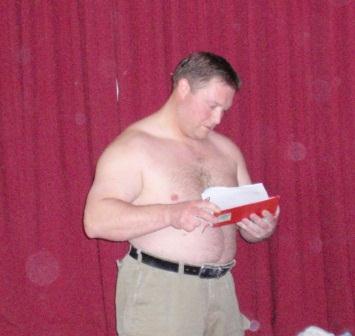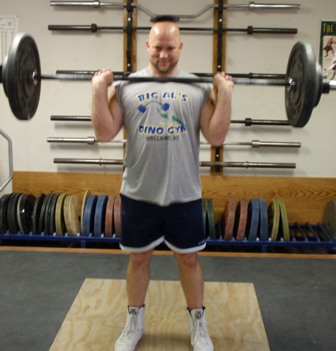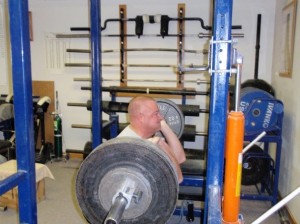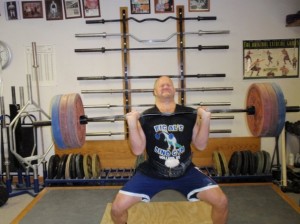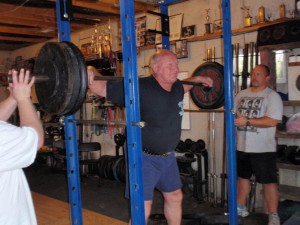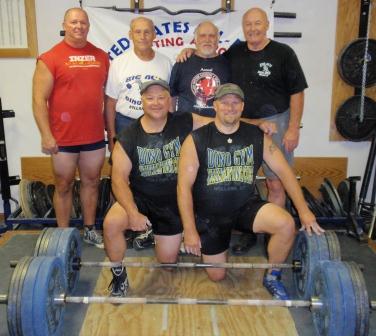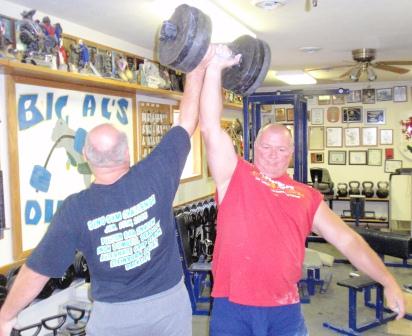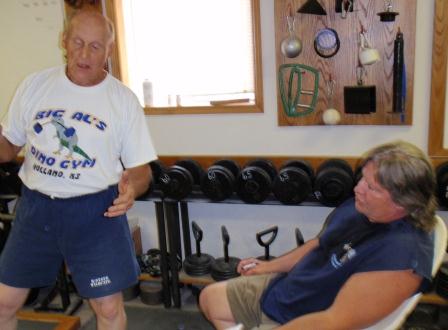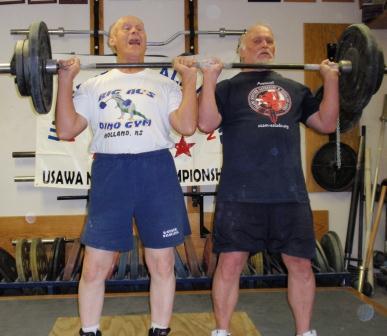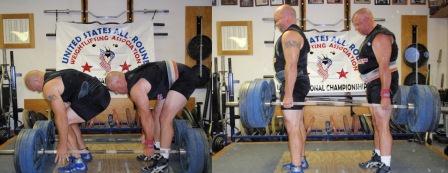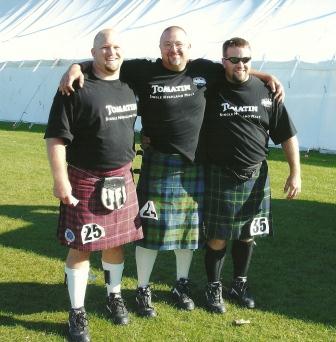All Round Lifting: The Big Brother Version
by Al Myers
Last month at the IAWA World Championships in Perth, Australia, several of us rented a beach house together. I organized this beach house rental for a couple of reasons – to save a little money and also to spend some time with a few of the masterminds in the organization. Six of us spent close to 10 days living together – myself, Chad Ullom, USAWA President Denny Habecker, IAWA President Steve Gardner, English All Round lifting sensation Mark Haydock, and the MAN OF STEEL and all-round lifting legend Art Montini. This gave me the perfect opportunity to “pick their minds” and hopefully “steal” some secret lifting information from them. I liken myself to that of Robin Hood – but instead of stealing moneyI like to steal ideas from the rich and give to everyone else (ok – I won’t call you poor!). But I was also worried that this living arrangement would turn into an episode of BIG BROTHER in which we would be at “each other’s throats” by the end of the stay! I envisioned the alliances – the Americans versus the Brits (of which I knew ahead of time we would have the numbers on this one), the Wily Veterans (Denny, Steve, & Art) versus the Newbies (Chad, Mark, & myself), or the Drinkers versus the Nondrinkers (which would be pretty much everyone versus Art!!). Who would be the first one voted out of the house? Luckily, no “drama” ever developed throughout the week so I can’t report on any fights or anything like that.
But I did learn alot. Like I said, I spent every moment trying to steal some important secret from my roommates. And like Robin Hood, I plan to share with you everything I learned from these guys. I consider these guys the “movers and shakers” of All Round Lifting. Steve is closing in on 12 years as IAWA President and many, many years as the IAWA(UK) President. He has been involved in the sport for over 20 years. Denny is our USAWA President and filled with secrets – it’s just that he doesn’t always talk alot about things and I have to “pry” information out of him. Mark was the 2009 IAWA World Champ and I knew for sure he knew something that would be to my benefit in my training. Art is the “most seasoned” of all these guys and for sure he had something “to give up”. Now with Chad, well let’s just say, I’ve already stole all of his secrets, which isn’t much. I planned to strategically just use him for distraction purposes to give me “a little one on one” time with my targets.
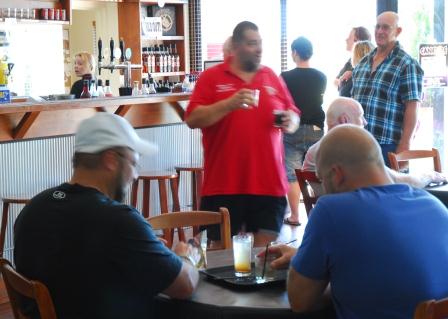
Steve feels "right at home" in a brewery or a pub. And YES - Steve has a drink in each hand, drinking both at the same time.
When you live with “your competitors” for a week you really learn something about them. My primary focus of this investigation was with Steve. He is a born leader, takes charge in everything he does, and I was hoping to find the secret of his sucess or perhaps a weakness in his personality. Well, I only found a couple, and they were weaknesses. Just say I was dissappointed! First, he snores like a sailor blowing a fog horn. It didn’t take the rest of us long to realize that his sleeping arrangement needed to be a FAR DISTANCE from the rest of us. We put him in a room on the other side of the house which only was close to Denny’s room, and that was on purpose as well, because Denny was suffering from some bad case of bronchitis and was coughing non stop. He sounded like a dog with kennel cough. I often had to get up in the middle of the night (if you must know it was to pee) and the bathroom was close to their rooms. I listened for several minutes to these two “barking in the night” and I swear they were in unison with their nightly sounds. I think Denny was doing the harmonizing.
The only other weakness I found with Steve was his passion for beer. Now I’m not saying he is a drunk, he just enjoys his barley beverage. Chad and I even set up “a trap” for him to see if he would drink anything. We bought this really nasty beer that we wouldn’t even drink, and left it in the fridge. Sure enough, Steve finished off the six-pack while the rest of us watched in amazement. He even said he LIKED IT! He’s a passionate beer connoisseur.
Another of my “targets” was Mark Haydock. After watching him smash a couple of Chad’s World Records at the Gold Cup, I knew he must have some lifting secrets. It took me all week but I finally found out the reason for Mark’s lifting success. I caught him reading Steve Justa’s book ROCK IRON STEEL. I knew immediately that had to be his secret training program – why else would he have carted that book the entire way from England to Australia??? A couple of times I “took a peak” at this secret book of his when he wasn’t looking. Chad even snuck the book of to the private room a few times to read it. I bet Mark was rereading that book for meet motivation!! I got to get that book now so I will know Mark’s secret training programs. But I will say this about Mark, I had the feeling that he was studying me as well. He kept asking me questions that I was uncomfortable in answering. I felt like he was trying to steal MY SECRETS! He also bought this porridge that he was letting on as the “secret of his strength”. I had it one day for breakfast and it about made me puke. I think he was setting me up like I did Steve on the beer. But Chad had the porridge EVERY DAY convinced it would make him stronger. Everyone needs to have a gullible friend like Chad.
Like I said, Denny is a “tough nut to crack”. He often just “sits back” and laughs along with everyone else’s jokes, and never really contributes any jokes of his own. But I also found Denny’s secret to his strength during this week. Even though he may limp around and look like he needs help getting out of a chair, Denny is INDEED a very conditioned athlete! The gimpy persona is just a hoax. He acts this way just so his competition doesn’t take him too serious. I marveled at how he worked this to perfection at the meet against his arch rival, Frank Allen. Now, how do I know this? Well, after the meet Chad and I had planned to take a day trip to Rottnest Island, a small island off the coast of Perth. We planned to spend the day bicycling around the island, a distance of over 30 miles and up and down many hills. Denny asked to join us, and at first I was thinking this might be an issue. I was initially worried that he wouldn’t be able to “keep up” with Chad and me and we would need to call in the rescue unit. But after the day’s big bike ride, in which was as easy for Denny as a “walk in the park”, I knew he was just faking us out all the times in the past when he would wobble around like a rookie on rollerskates. On the ferry ride back to Perth, I asked him how he was in such great shape and he told me that he used to ride his bike 100 miles a day!!! What??? I’m still “tossing that around” in my mind. Just visualizing Denny in my mind biking 100 miles makes my heart go into palpatations. It was at that point that I decided I wasn’t going to admit to Chad and Denny that a couple of times I had to get off my bike and walk it up a couple of big hills.
With Art, I already knew his secret of his strength, and it just doesn’t work for me. I discovered it a couple of years ago when I stayed at his house for a meet in Ambridge. It involves getting up really, really early to train (3-4 AM) and then eating donuts afterwards. I’m going to save that secret for later in my life and then “pull it out of the bag” when I need it. But I will say this about Art, he acts MUCH YOUNGER than his biological age and there must be something to that as well in his secret to success on the platform. I should also mention Art’s special spaghetti, which must have something to do with his lifting longevity. I have had it before and he made it for us in Perth. Art makes some of the BEST spaghetti I have ever tasted.

When it comes to icecream, Chad is the expert. He will sample taste every flavor before making his choice!
Who did I forget? Oh Chad. Well like I said earlier, Chad has no secrets when it comes to training. But I do know his main weakness – ICECREAM! We had to make several stops during the week for icecream and if he keeps this up I will not have to worry about him because he will be out of my weight class and get KILLED on the Lynch Formula! There are other things about Chad – but they are blood oath stories so I won’t tell.
I will say that week in Australia was one of the most fun weeks of my life!!
